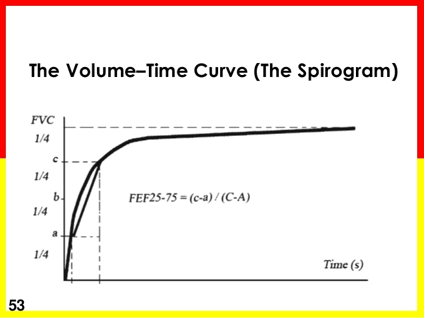Spirometry: Auscultation Lessons, Sounds, Video
Spirometry Definition
Quite simply, spirometry measures two basic elements:
1) The amount of usable air in the lungs (vital capacity)
2) How fast the patient can blow the air out
Spirometry is a component of pulmonary function testing. While a complete pulmonary function test takes place in a dedicated lab, spirometry can be performed at the bedside or in an office.
PowerPoint Slides
We have created a Spirometry Presentation to introduce the principles of spirometry. This presentation also provides a introduction to interpretation of the values obtained. The author has established these objectives for the learner:
- Define the basic lung volumes and capacities
- Describe how the test is performed and the values obtained
- Describe basic qualities assurance measures to ensure the accuracy of the results
- State the significance of the data, especially for COPD and asthma
- Given a set of spirometry data, provide a basic interpretation
Spirometry Interpretation - Data Review
What Data Tells You
Once the testing is complete, review the data obtained and ask questions such as:
- Is it a good test, that is, are you satisfied that the subject put forth the best effort possible?
- To determine this, look at the data: Do you have two sets of data that are close in value; do the flow/volume loops overlap? Also, look at the PEFR.
- Are all the values within normal limits (80% - 120% of what was predicted for the subject)?
- If the values are not all within normal limits, is the abnormality more indicative of a restrictive disorder or an obstructive disorder (or possibly both)? If the FEV1, FEV1/FVC, and/or FEF25%-75% is low, the abnormality is most likely obstructive. If the flows are normal but the FVC is low, the abnormality is most likely restrictive (however, this needs to be confirmed by measuring the TLC in a PFT lab).
Spirometry Normal Values
Normal values for each data point obtained during spirometry is derived from a predictive equation and is patient specific. The predictive equations require the patient’s gender, height, weight, and age. Some predictive equations also include race. Fortunately, nearly all modern spirometers automatically calculate the patient’s predicted values. The data point is generally considered normal if it falls within 80% to 120% of what has been predicted.

Spirometry Terms & Concepts
- Total Lung Capacity (TLC). The maximum amount of air the lung can hold.
- Vital Capacity (VC). The maximum amount of air that can be exhaled following a maximum inhalation.
- Forced Vital Capacity (FVC). The vital capacity obtained when the subject is blowing out as hard and fast as possible.
- Residual Volume (RV). The amount of air remaining in the lungs following a maximum exhalation.
- Functional Residual Capacity (FRC). The amount of air remaining in the lungs following a normal exhalation.
- Volume. Recall that spirometry measures the amount of usable air in the lungs. This is the vital capacity. And because the subject is asked to blow out as hard and fast as possible, the value obtained is the forced vital capacity.
- Residual Volume. Note that spirometry cannot measure residual volume, functional residual capacity, or total lung capacity since residual volume cannot be exhaled. These values need to be obtained by other means in a pulmonary function lab.
- Flow. Recall that part of spirometry is determining how fast the subject is able to exhale (or blow out) their vital capacity. The primary reason this is measured is because in certain diseases such as COPD and asthma, the patient’s ability to exhale is compromised.
There are generally three or four measures of a subject’s ability to exhale hard and fast.
- Forced Expired Volume in the first second (FEV1). This is a measure of how much of the FVC the subject exhaled in the first second. A normal person will exhale around 80% of their FVC in the first second.
- FEV1/FVC. This is the percent of the FVC that person exhaled in the first second (see above). Both measures are important to look at together because if the FVC is low, the FEV1 will also be low (as in restrictive diseases such as idiopathic pulmonary fibrosis; however in these diseases, the person’s ability to exhale is not usually compromised).
Other Flow Measures
- Forced Expiratory Flow between 25% and 75% (FEF25-75). This is the average flowrate calculated as the subject is exhaling between 25% and 75% of his/her FVC. Think about it this way: As the subject forcibly exhales the FVC, the rate at which the flow is leaving the lungs is not constant, but rather changes over the length of exhalation.
- Peak Expiratory Flow (PEF or sometimes PEFR). The highest flowrate the subject attains during exhalation. It usually occurs at the beginning of exhalation. Often used as an indication of effort.
Sample Graphs


Sign-in to enable progress reports and certificates.
Authors and Reviewers
-
Heart sounds by Dr. Jonathan Keroes, MD and David Lieberman, Developer, Virtual Cardiac Patient.
- Lung sounds by Diane Wrigley, PA
- Respiratory cases: William French
-
David Lieberman, Audio Engineering
-
Heart sounds mentorship by W. Proctor Harvey, MD
- Special thanks for the medical mentorship of Dr. Raymond Murphy
- Reviewed by Dr. Barbara Erickson, PhD, RN, CCRN.
-
Last Update: 11/10/2021
Sources
-
Heart and Lung Sounds Reference Library
Diane S. Wrigley
Publisher: PESI -
Impact Patient Care: Key Physical Assessment Strategies and the Underlying Pathophysiology
Diane S Wrigley & Rosale Lobo - Practical Clinical Skills: Lung Sounds
- PESI Faculty - Diane S Wrigley
-
Case Profiles in Respiratory Care 3rd Ed, 2019
William A.French
Published by Delmar Cengage - Essential Lung Sounds
by William A. French
Published by Cengage Learning, 2011 - Understanding Lung Sounds
Steven Lehrer, MD
- Clinical Heart Disease
W Proctor Harvey, MD
Clinical Heart Disease
Laennec Publishing; 1st edition (January 1, 2009) -
Heart and Lung Sounds Reference Guide
PracticalClinicalSkills.com
How to use a stethoscope